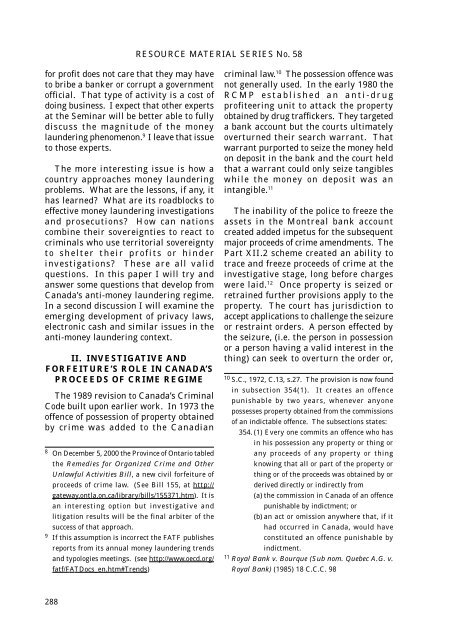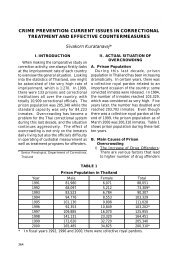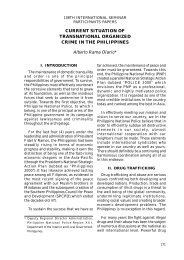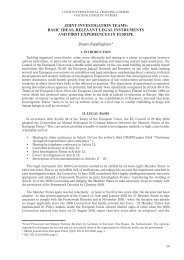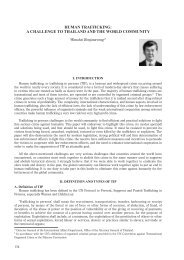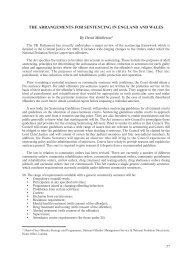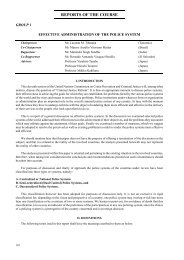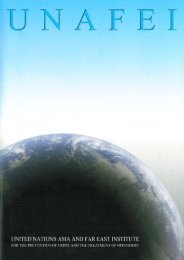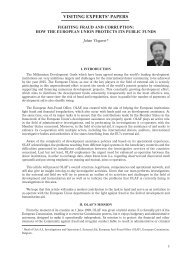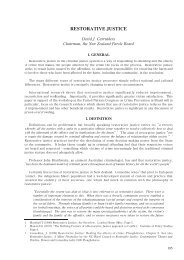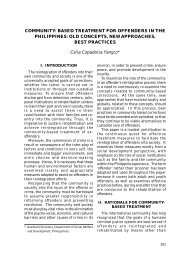CANADA'S ANTI-MONEY LAUNDERING REGIME Daniel P. Murphy *
CANADA'S ANTI-MONEY LAUNDERING REGIME Daniel P. Murphy *
CANADA'S ANTI-MONEY LAUNDERING REGIME Daniel P. Murphy *
You also want an ePaper? Increase the reach of your titles
YUMPU automatically turns print PDFs into web optimized ePapers that Google loves.
RESOURCE MATERIAL SERIES No. 58for profit does not care that they may haveto bribe a banker or corrupt a governmentofficial. That type of activity is a cost ofdoing business. I expect that other expertsat the Seminar will be better able to fullydiscuss the magnitude of the moneylaundering phenomenon. 9 I leave that issueto those experts.The more interesting issue is how acountry approaches money launderingproblems. What are the lessons, if any, ithas learned? What are its roadblocks toeffective money laundering investigationsand prosecutions? How can nationscombine their sovereignties to react tocriminals who use territorial sovereigntyto shelter their profits or hinderinvestigations? These are all validquestions. In this paper I will try andanswer some questions that develop fromCanada’s anti-money laundering regime.In a second discussion I will examine theemerging development of privacy laws,electronic cash and similar issues in theanti-money laundering context.II. INVESTIGATIVE ANDFORFEITURE’S ROLE IN CANADA’SPROCEEDS OF CRIME <strong>REGIME</strong>The 1989 revision to Canada’s CriminalCode built upon earlier work. In 1973 theoffence of possession of property obtainedby crime was added to the Canadian8 On December 5, 2000 the Province of Ontario tabledthe Remedies for Organized Crime and OtherUnlawful Activities Bill, a new civil forfeiture ofproceeds of crime law. (See Bill 155, at http://gateway.ontla.on.ca/library/bills/155371.htm). It isan interesting option but investigative andlitigation results will be the final arbiter of thesuccess of that approach.9 If this assumption is incorrect the FATF publishesreports from its annual money laundering trendsand typologies meetings. (see http://www.oecd.org/fatf/FATDocs_en.htm#Trends)criminal law. 10 The possession offence wasnot generally used. In the early 1980 theRCMP established an anti-drugprofiteering unit to attack the propertyobtained by drug traffickers. They targeteda bank account but the courts ultimatelyoverturned their search warrant. Thatwarrant purported to seize the money heldon deposit in the bank and the court heldthat a warrant could only seize tangibleswhile the money on deposit was anintangible. 11The inability of the police to freeze theassets in the Montreal bank accountcreated added impetus for the subsequentmajor proceeds of crime amendments. ThePart XII.2 scheme created an ability totrace and freeze proceeds of crime at theinvestigative stage, long before chargeswere laid. 12 Once property is seized orretrained further provisions apply to theproperty. The court has jurisdiction toaccept applications to challenge the seizureor restraint orders. A person effected bythe seizure, (i.e. the person in possessionor a person having a valid interest in thething) can seek to overturn the order or,10 S.C., 1972, C.13, s.27. The provision is now foundin subsection 354(1). It creates an offencepunishable by two years, whenever anyonepossesses property obtained from the commissionsof an indictable offence. The subsections states:354. (1) Every one commits an offence who hasin his possession any property or thing orany proceeds of any property or thingknowing that all or part of the property orthing or of the proceeds was obtained by orderived directly or indirectly from(a) the commission in Canada of an offencepunishable by indictment; or(b) an act or omission anywhere that, if ithad occurred in Canada, would haveconstituted an offence punishable byindictment.11 Royal Bank v. Bourque (Sub nom. Quebec A.G. v.Royal Bank) (1985) 18 C.C.C. 98288


